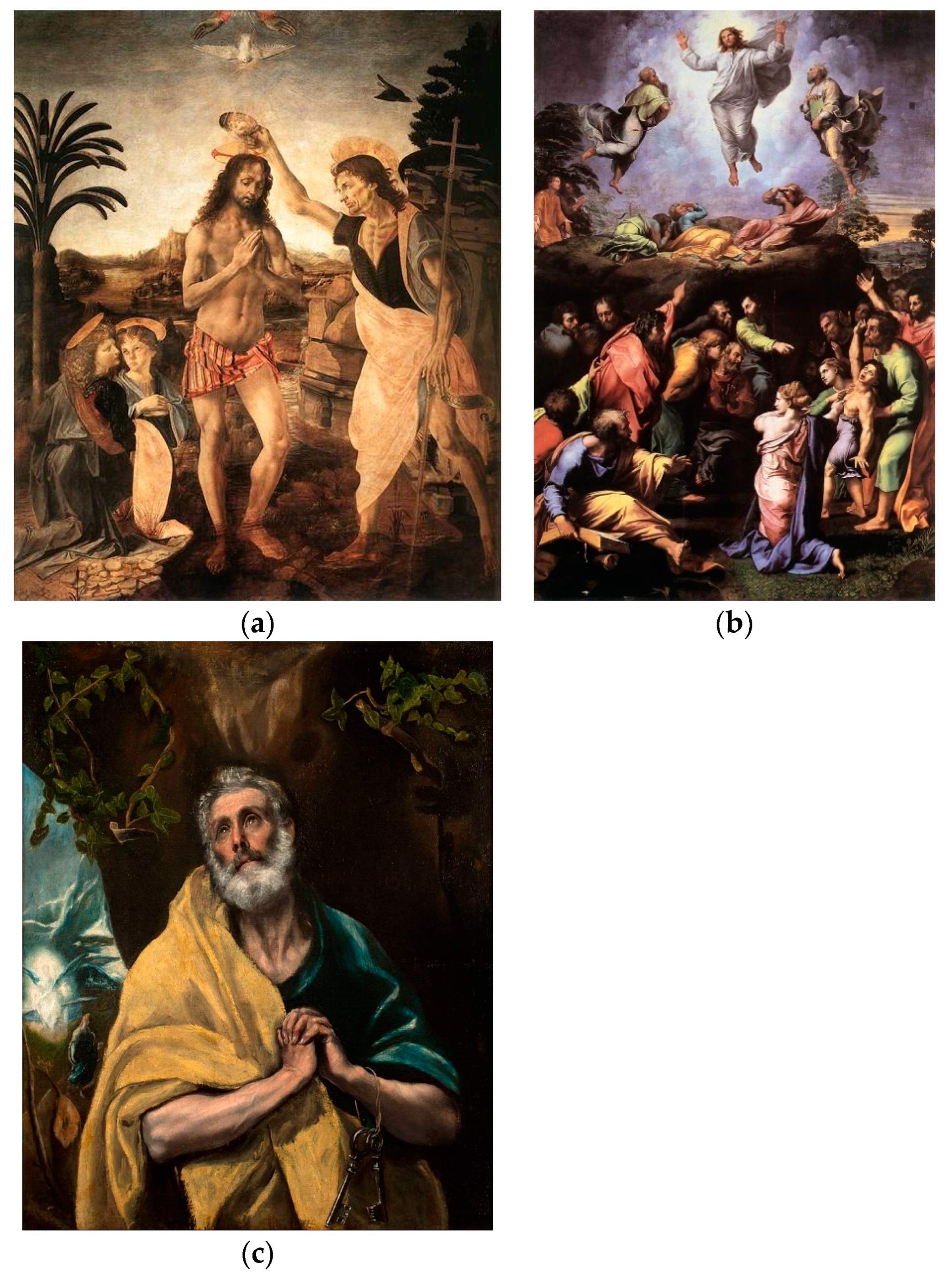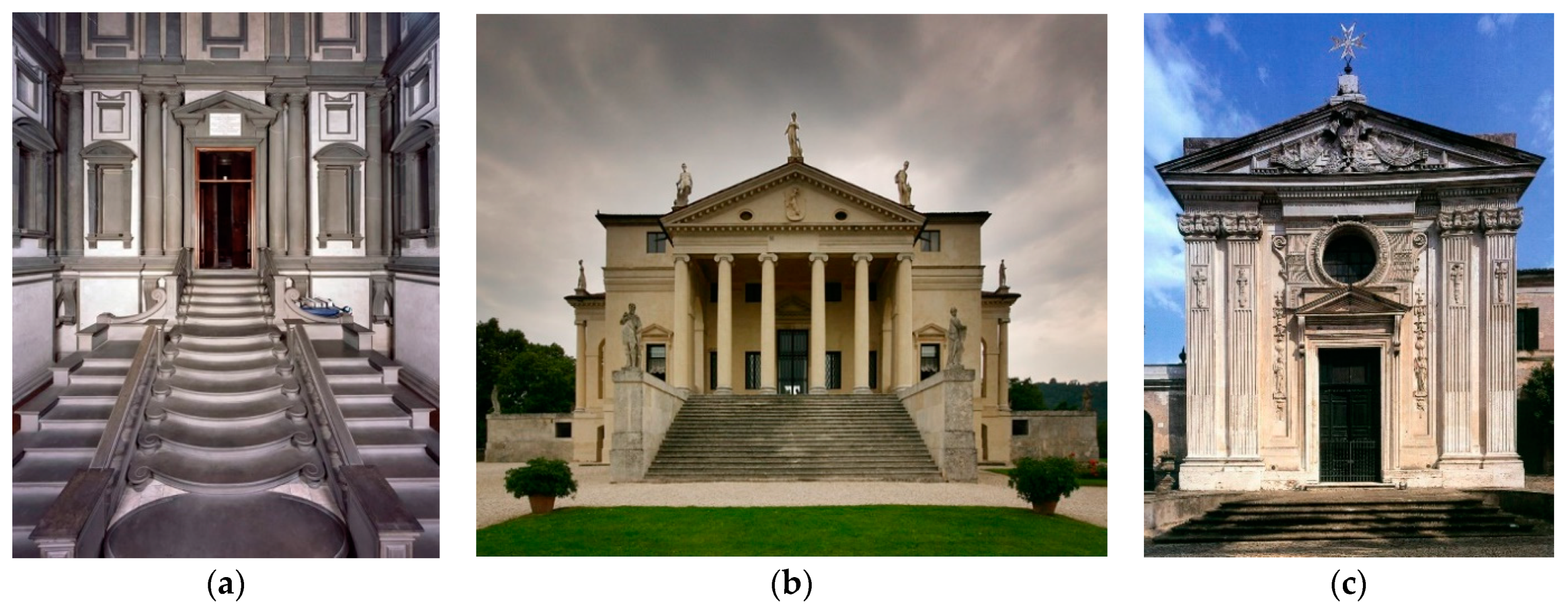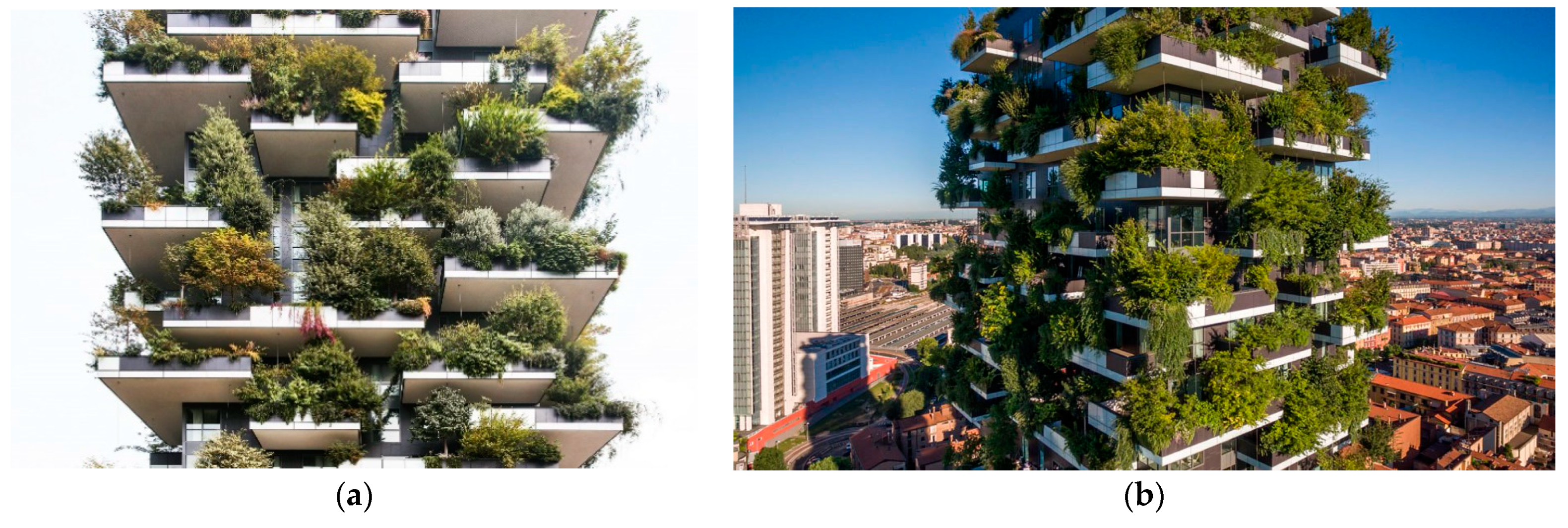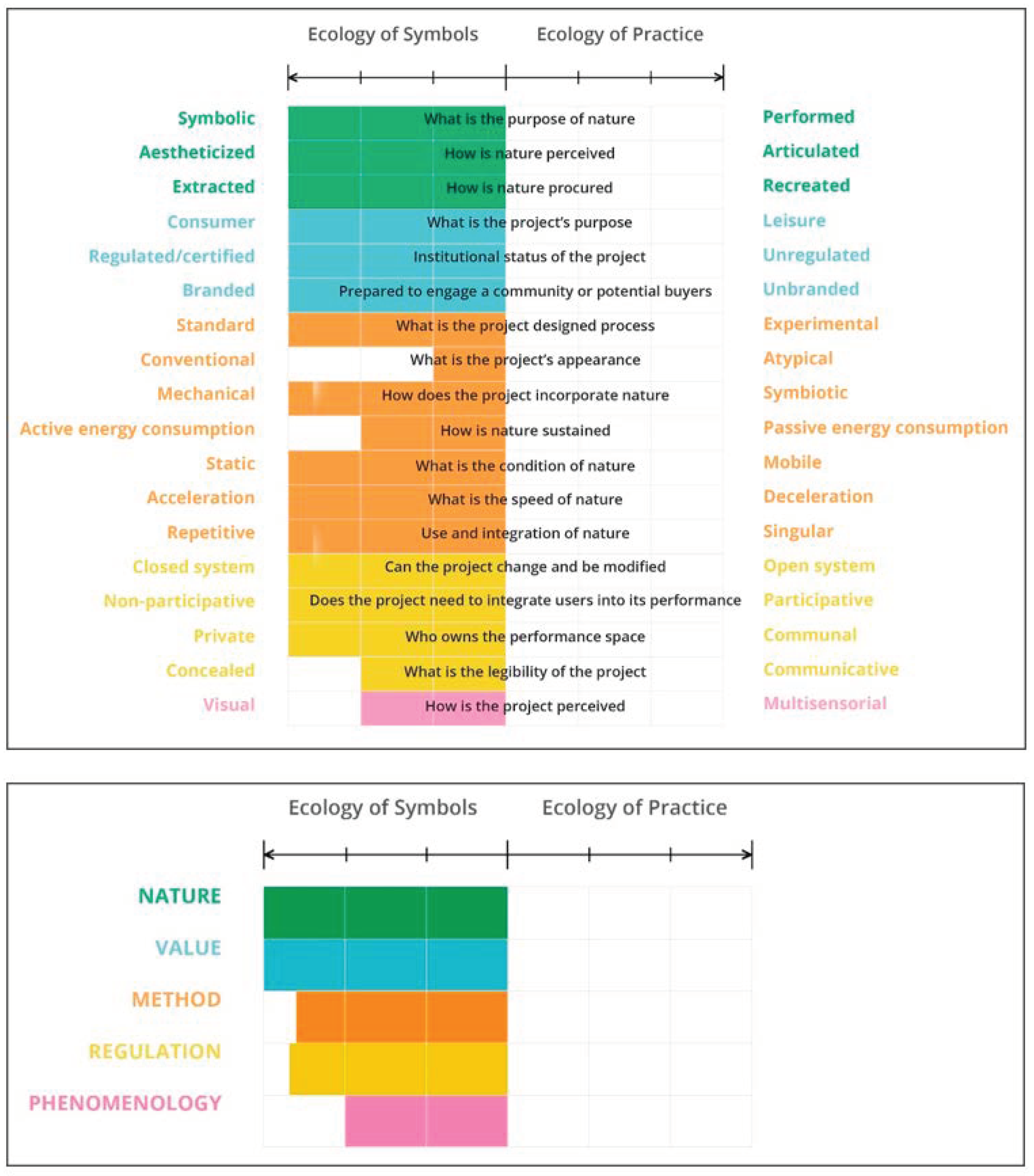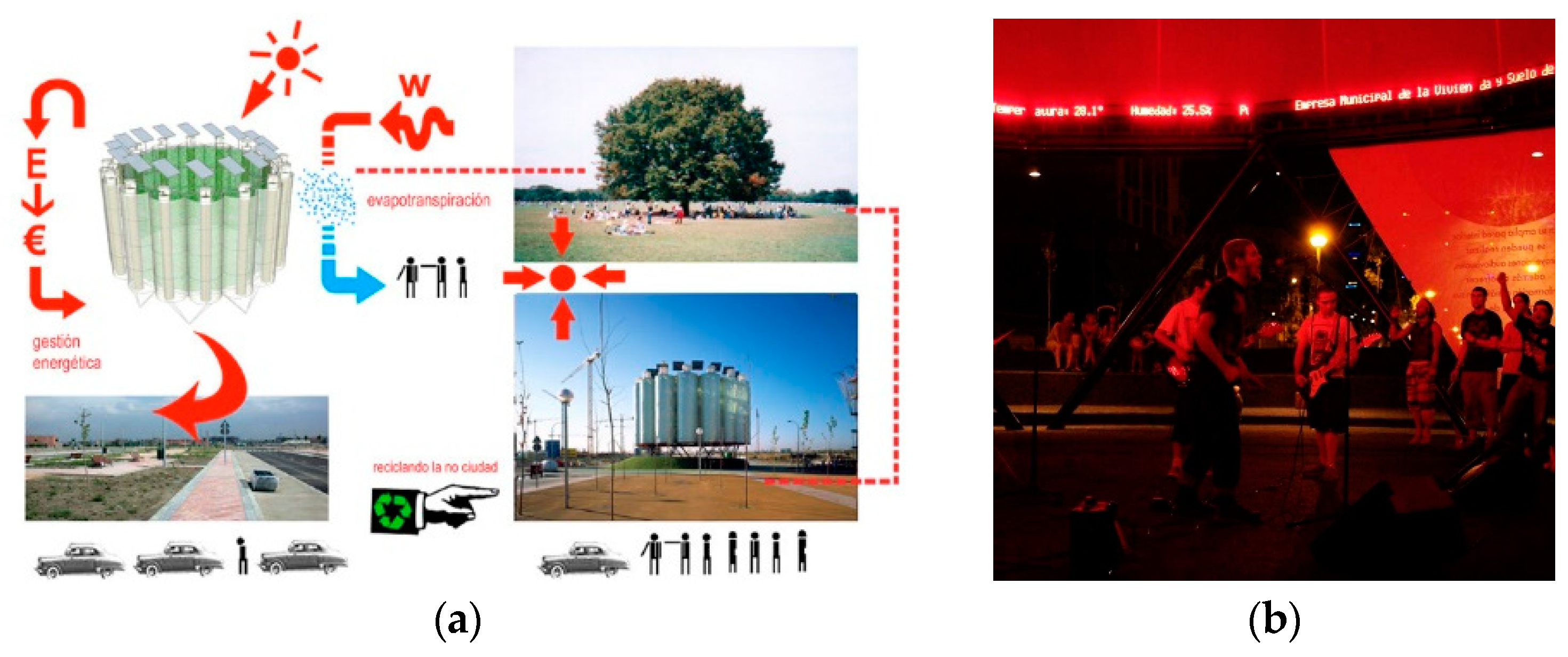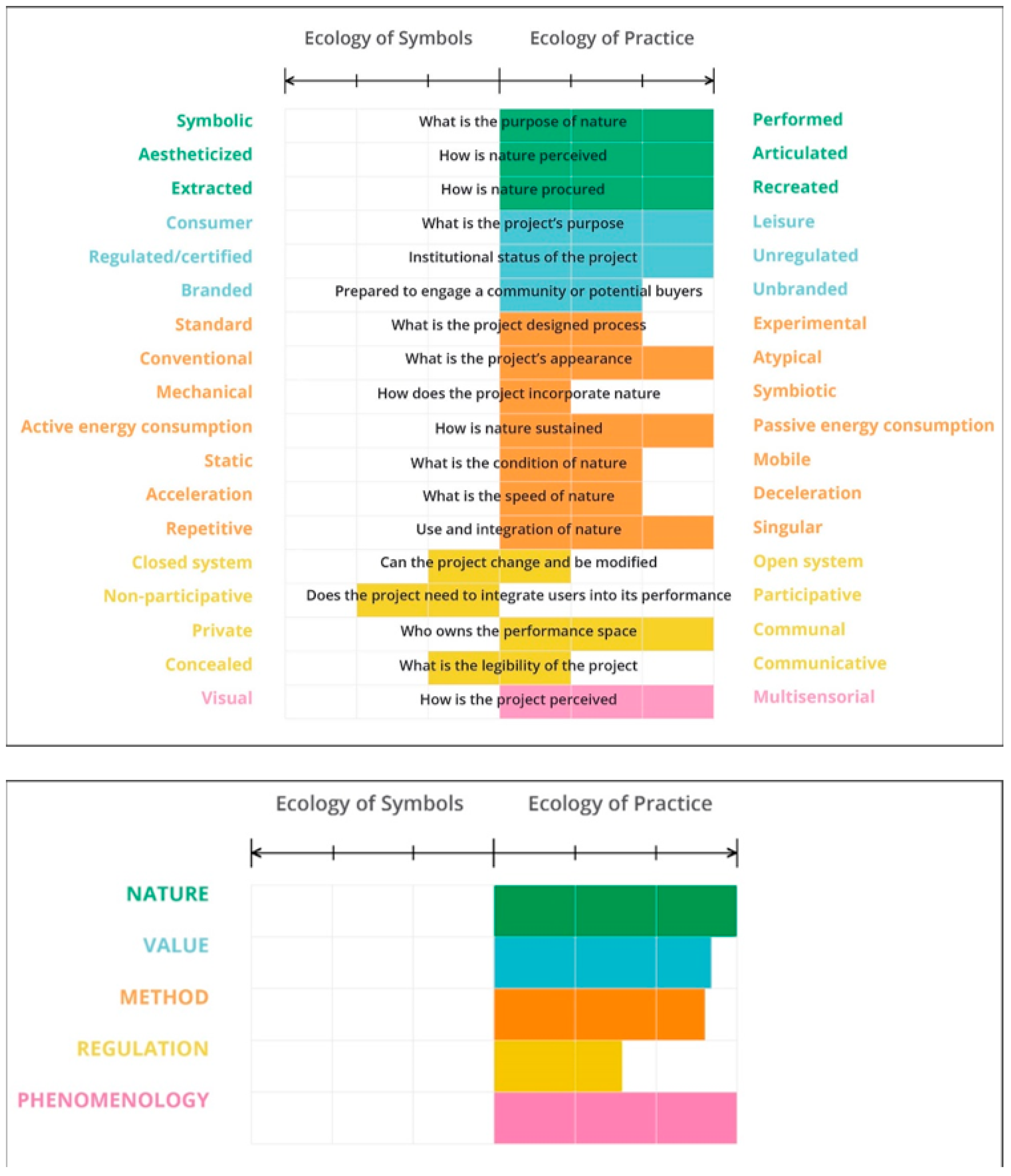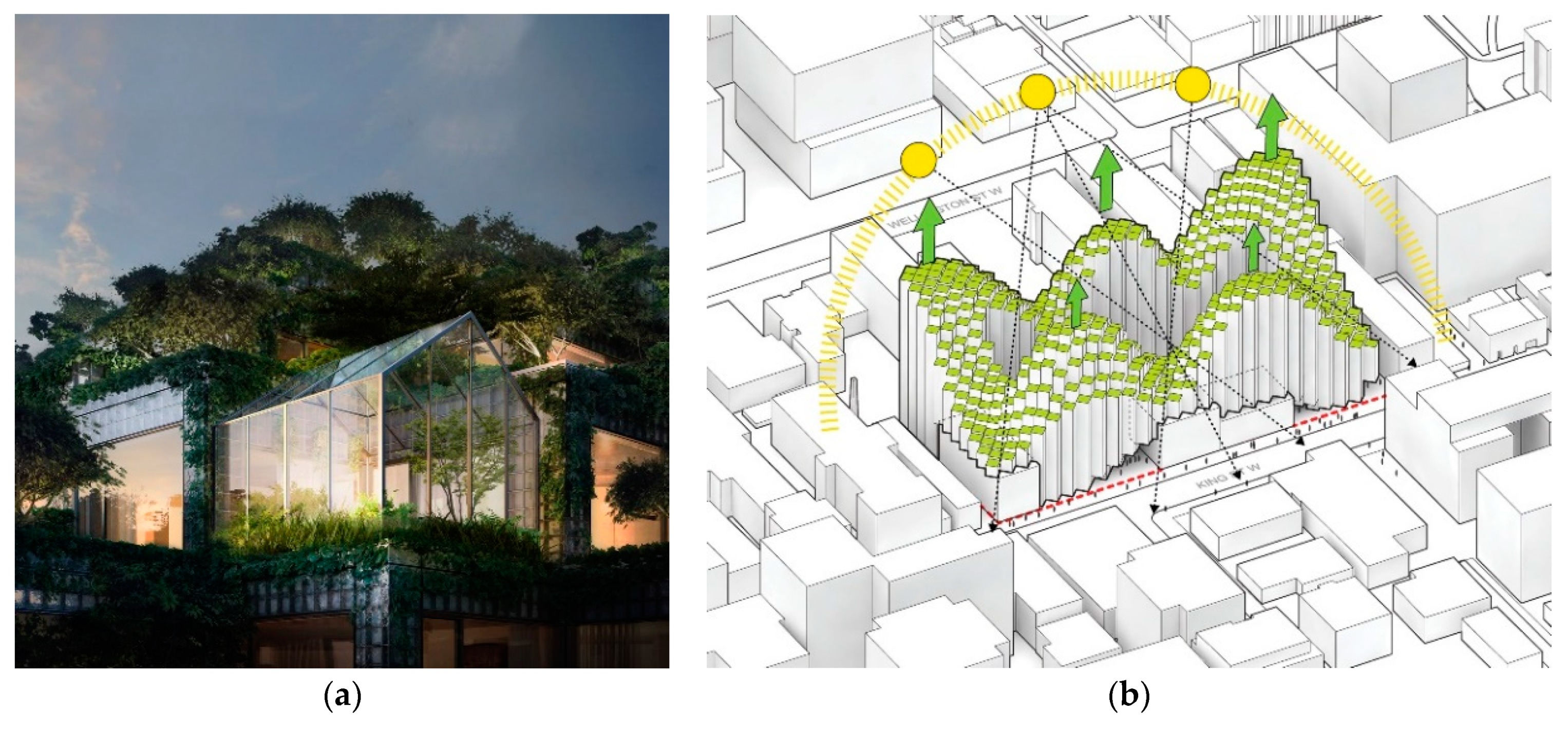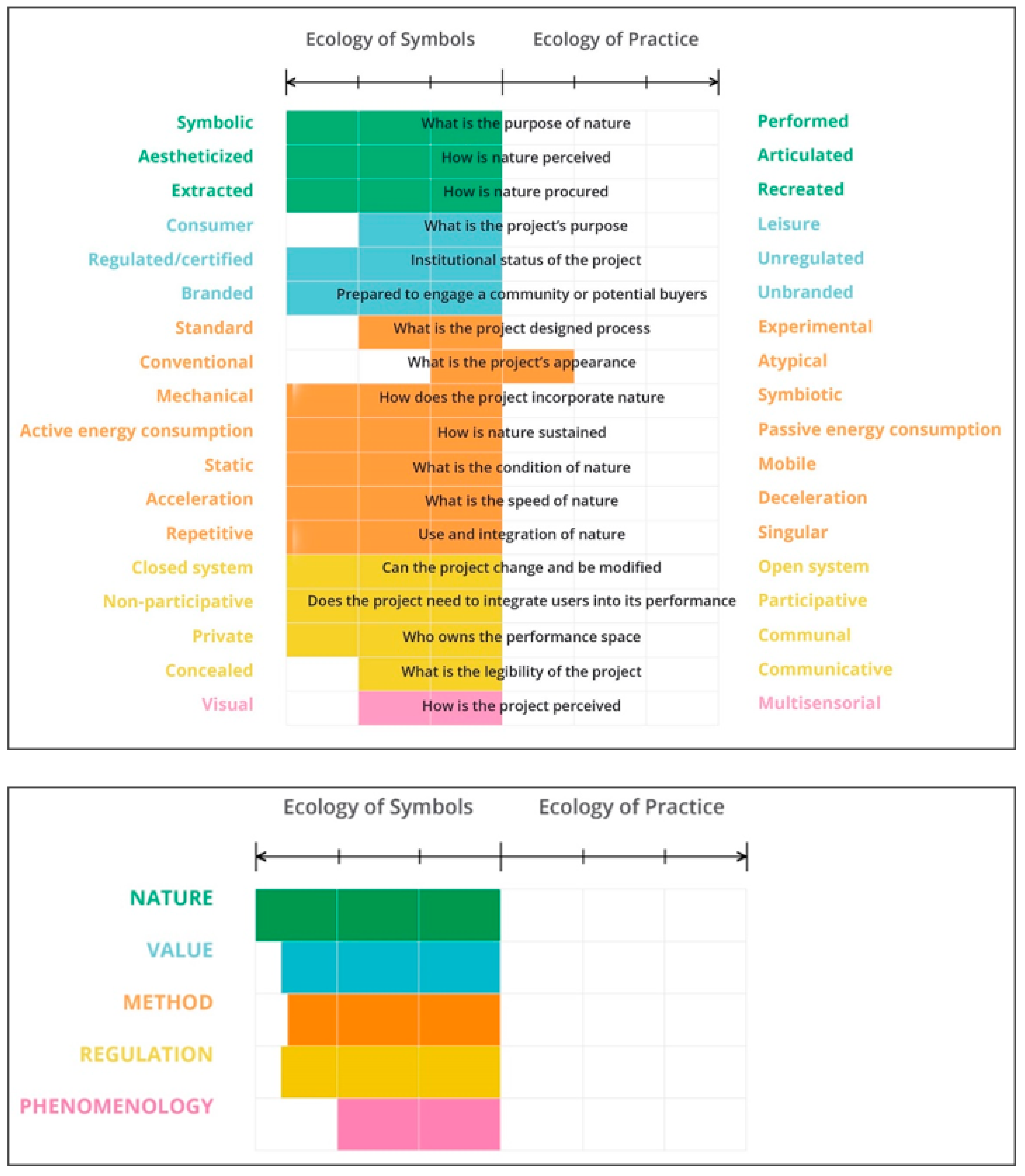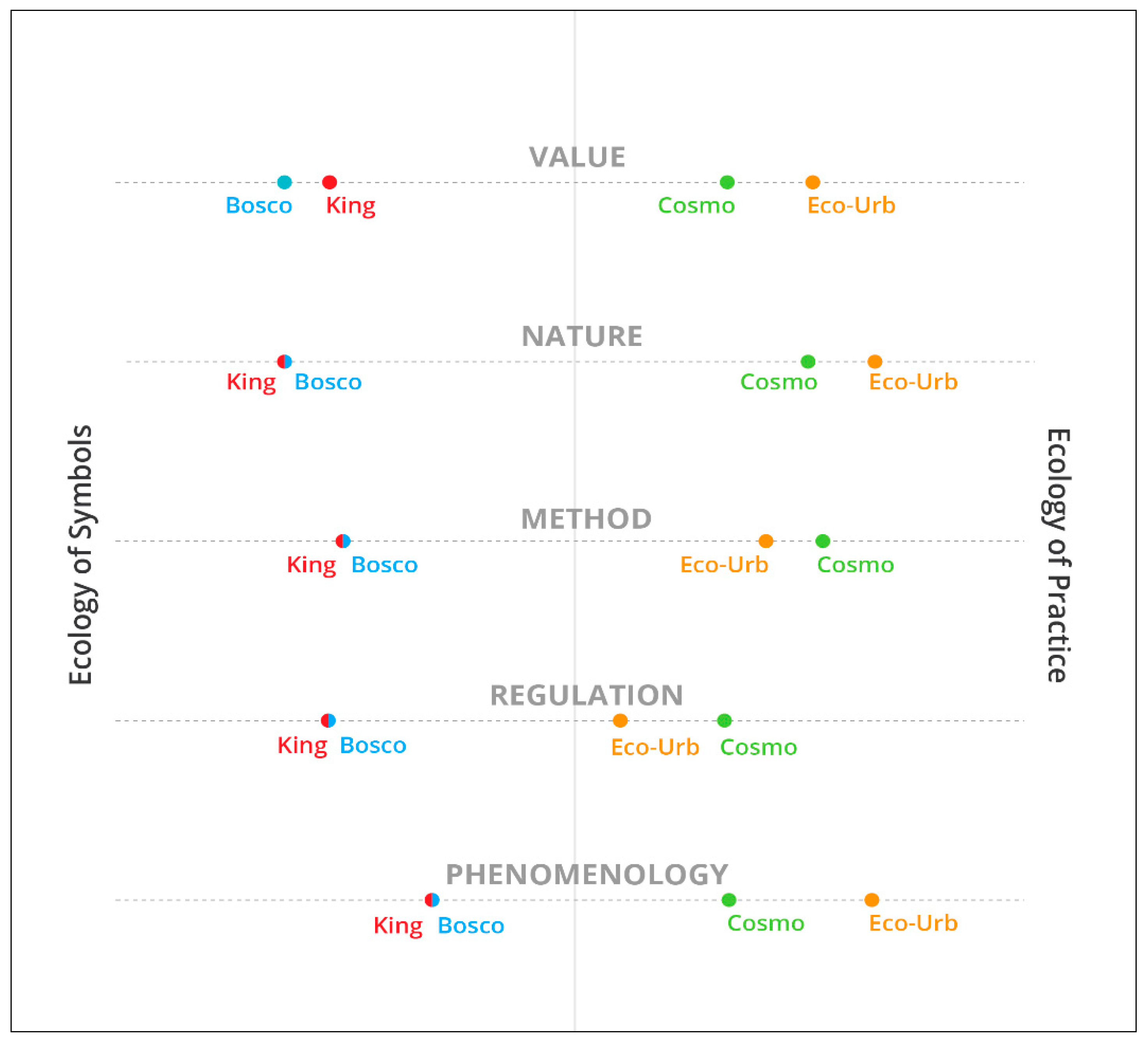1. Introduction
Between 1520 and the end of the 16th century, late Renaissance transformed into Mannerism, which was seen as a bridge towards the Baroque, or Renaissance dissolution, and was characterized by the destabilization of compositional elements, colors, and subjects, very often exposed in the mannerist body. Mannerism requires the gesture of an artist in order to be identified, either artistically, socially, or symbolically. It gets its most distinctive characteristics from the way the artist moves and uses their expressiveness to imbue meaning into a work. The goal of this text is to conceptualize Mannerism as an approach in contemporary architecture that makes use of an Eco-feature to artificially express an architecture imbued with a social, symbolic veneer of sustainability, rather than embodying actual sustainable performance. An Eco-feature is a designed element that integrates vegetation in architecture to improve architectural performance [
1], and Ecomannerism explores and identifies when these elements carry a higher environmental load “associated with implementation and maintenance” [
2]. When architects break the balance between the performativity of nature and its symbolical value, then sustainability becomes ‘sustainabil-ism’ [
3,
4]. Ecomannerism also expresses the verdolatry as defined by philosopher Alain Roger, in both architects and users who transform nature’s value in favor of its aesthetic value to communicate sustainability in an intervention [
5], where “the integration of vegetation into the built spaces becomes an idolatry” [
4].
We will identify the etymological roots of ‘Eco’ and ‘Mannerism’ in order to place boundaries on both our description and the ways we envisage that the concepts operate. We will seek in our conception of Mannerism a “supratemporal category, de-historized, which may become operative and ground new artistic [and architectural] representations of our time.” [
6]. This will not be the first time Mannerism has been applied in such a way. One may remember how “Mannerism provided artists and critics with the tools to wage a proxy struggle against High Modernism while prompting them to scrutinize their own roles and behaviors within the court of the mid-sixties art world.” [
7]. We will approach this task in two ways. The first will use Wylie Sypher’s description of Mannerism, where the new style meant the decay of classical aesthetics, the corruption of values, and a disassociation from, and contradiction of reality. The second approach will focus on the etymological isolation of the gesture, the manniera, using Octavio Paz’s writings on the ‘artist gesture’ used in the production of Duchamp’s readymades. To understand our concept, Ecomannerism, we must first unpack its complexity. The concept is composed of the prefix
Eco, the root manniera, and the suffix -ism. Moving from first-morpheme to last, then, we will now define our boundaries and references for the prefix ‘eco’. To complete this work, we assume the intertwined nature of art, ecology, architecture, and sustainability in the built environment. Therefore, ecomannerism is an interdisciplinary concept concerned with the interpretative potential of buildings to communicate in an expressive and didactic way ecological values that form part of sustainable systems in architecture that directly affect the built environment.
2. Eco-Logy
Beginning with etymology, we can see that the word ecology (n.) dates back to 1873. Coined
Ökologie by German zoologist Ernst Haeckel, the word was originally derived from Greek
oikos, “house, dwelling place, habitation” [
8]. Its current definition can refer to two main ideas [
9]. On the one hand, it can refer to “the study of the relationships between plants, animals, people, and their environment, and the balances between these relationships.” On the other, ecology can refer to “the pattern and balance of relationships between plants, animals, people, and the environment in that place.” [
9].
Ecology was taken the disciplinary realm of biology by anti-pollution activists in the 1960s, who sought to restore the balance between all living elements threatened by the extractive practices of capitalism. During this time, the predominant concern was to restore balance and reverse the increasing damages evident in soil, air and water pollution, which were already shown to be harming biodiversity and natural resources. In 1968, the international and interdisciplinary organization, Environmental Design Research Association (EDRA) was founded by design professionals, scholars, and social scientists, among others. Their purpose was to advance environmental design by improving the relationships between people and their settings, both built and natural. They adopted a holistic approach to the spatial design of human and natural habitats [
10]. However, the 1970s brought with it a technological emphasis, introducing various technologies to reduce energy use, such as photovoltaics. This was pushed further in the early 1980s with a school of thought in the social sciences that argued the economy could benefit from environmental action. This was termed ecological modernization. This approach to ‘protecting’ the earth’s ecological systems found its footing in international discourse as a policy strategy for environmental productivity [
11]. Some examples of its application include increases in energy and resource efficiency, clean technologies, sustainable supply chain management, etc. At the turn of the new millennium, however, the limitations of this framework began to become apparent [
12].
Indeed, in 1973 Arne Naess in his influential paper, The Shallow and the Deep, Long-Range Ecology Movement. A Summary, attempted to characterize what he termed ‘shallow’ and ‘deep’ ecology [
13]. He claimed that ecologists, formerly in relative obscurity, were now seeing a turning point in the scientific community, where their message was being twisted and misused. Naess claimed that policy was adopting a shallow version of ecological responsibility that only considered some parts of pollution prevention and resource depletion. It was ignoring the broader principles of ecological responsibility, such as diversity, complexity, autonomy, decentralization, symbiosis, egalitarianism, and classlessness. Moreover, Rachel Carson, in her book Silent Spring recognized that the interaction between living things and their surroundings is a historical relationship where the forms of living things have been molded by their environment [
14]. According to Carson, it is only in recent history that one species, the human, has altered the nature of the earth forever.
Since the 1970s, however, the term ecology has come to permeate such varying disciplines as biology, earth sciences, environmental sciences, entrepreneurial activities, and systems thinking, among others. Its abbreviation, ‘ECO-’, often used as a prefix to a variety of concepts, has become extremely prolific. For example, more recently, the terms eco-bling and eco-minimalism have been used to characterize different approaches to improving sustainability during architectural design and construction [
15]. These two expressions essentially represent polar opposites: eco-bling tends to use inappropriate, superfluous, and blatantly visible eco-technology, whereas eco-minimalism stands in opposition to this. Expressions that lie on completely opposite sides of the conceptual spectrum, it seems, can share the same prefix. ECO-, applied to a broad set of fields and ideas, has somehow lost its meaning.
We now ask if ECO-, as it has come to be applied in contemporary architectural projects, can denote a new form of what was originally understood as a Mannerism. We will begin by exploring this second etymology.
3. Mannerism
Mannerism, as a style, emerged in Italy during the 16th century as a ‘transitional’ movement between the High Renaissance (1520s) and Baroque (1590s) styles. Etymologically, the term evolved from old French maniere “fashion, method, manner, way; appearance, bearing; custom”, from Vulgar Latin *manaria (source of Spanish manera, Portuguese maneira, Italian maniera), from fem. of Latin manuarius “belonging to the hand,” from manus “hand” [
16]. The geometric, perspectival, and life-imitating perfection achieved by Renaissance artists such as Leonardo, Michelangelo, and Raphael became a reflection of science and order that translated into a compositional purity to be imitated by their successors. The maturity of a classic renaissance period was ended, however, by mannerists, some of them being the very classical masters that had established it. By focusing on technique and refinement of established canons, mannerists diminished the values of concept and meaning, according to historians such as John [
17,
18,
19], Mannerism spoke of something other than the duplication of the visual realm, however, something that eventually started to depart, little by little, from the constrictions of reality imposed by the Renaissance. This was seen as a way to express something beyond the visible, defying “the rules of proportion and perspective to satisfy the needs of their subjective view of reality” [
19]. Bodies, no longer subject to space, perspective, or gravity (
Figure 1b), became vessels of an expression that deformed, elongated (Figura serpentinata), and flattened them. It is exactly this rupture that art strives for, in order to regain its capacity to render our reality beyond the constrictions of logic and rationalism, beyond the apparent “harmony and unity” [
19] that for Sypher characterized early and late Renaissance.
Paradoxically, the mannerist emphasis on technique devolved into an elegant and stylized artificiality (“The word ‘artificial’ which is now normally pejorative was not originally so, and in the sixteenth century the word ‘artifizzioso’ was wholly complimentary, and to a great extent concomitant with maniera. Benedetto Varchi (1548) defined the intention of artistic creation as ‘an artificial imitation of nature’, which is the more interesting for being a widely held view rather than an original one.” Shearman, John.
Mannerism. London: Penguin Books, 1967. p. 18. [
17]). In this way, its departure from Renaissance style implied a formal experimentation, defining itself through exaggeration of bodily virtues, such as the muscular floating struggles by Raphael at the Sistine Chapel. For some, like Hugh Smyth, Mannerism was a vice, a deviance from the classical Renaissance order. For Shearman, it was a natural and seamless evolution of the order towards Baroque. For Sypher, it reflected a crisis (disintegration) that crystalized in the splendor of the Baroque (reintegration/eclecticism). Mannerism was a period of disruption and change that assimilated and expressed the “virtues of aggression, anxiety and instability” [
17]. These ‘virtues’ can be seen in a comparison of the human body’s representation from Da Vinci’s Baptism of Christ (
Figure 1a) to El Greco’s The Tears of St. Peter (
Figure 1c). From a body grounded by gravity, rendered as closely as possible to nature, one can note a movement towards a body that seems to lean up into the sky, an elongated and colorful figure that transcends anatomical rendering by “inventing a new psychological vocabulary” [
19]. In Sypher’s words “Mannerism is full of contradictions: rigid formality and obvious “disturbance”, bareness and overelegance, mysticism and pornography, El Greco and Parmigianino” [
19].
In architecture, Mannerism is considered the last of the Renaissance periods, with the style being divided into Early Renaissance, High Renaissance, and Mannerism, which went beyond the constrictive order Renaissance ideals had over every segment of culture. The illusion of a perfect mathematical order, a Newtonian cosmos, was challenged by an architecture that exaggerated its elements and freed itself from the restraints of scientific and unitarian thought. We can think of Mannerism as a style that challenged Renaissance by transforming architecture into whimsical reproductions of nature imbued with mythological narratives, such as grottos. Other forms of challenge were posed by Michelangelo’s Laurentian Library vestibule (
Figure 2a), where “his architectural plan seems to be a framework for some shocking feats in sculpture and for niches, some of which, by a breakdown of logic, are left vacant (Turning) architecture into a medium for individual expression” [
19]. Michelangelo transformed ornamental elements in architecture into forms of personal expression, either by exaggerating them, or by employing them in odd ways, such as an empty niche. When those elements that were used to be ornamentation cease to be so, they produce a tension in space that for Sypher is perceived as ‘highly artificial.’ Palladio, one of the most influential architects of Mannerism, worked beyond a strict symmetrical order (
Figure 2b). He introduced a rich collection of architectural elements (including proportions) taken from his studies of Roman ruins and freed them from their mechanical function, to be transformed into highly refined elements of aesthetic expression. As Wittkower mentions, this “classical precedent … provided Palladio with the license to use ‘superimposition,’ ‘contradiction,’ and the ‘unfinished appearance’—in sum, ‘Mannerist factors as conflict and complication’ or ‘typical Mannerist inversions” [
20]. Giorgio Vasari uses the term during the XVI century to describe one of the four requirements of art: order, measure, design and manniera. Once Mannerism consolidated, it quickly started its own dissolution into an artform that would arise as Baroque. In Piranesi, we can see the conclusion of a long struggle fought for spatial, formal, and ornamental freedom. Piranesi took apart not only Renaissance order, but all the orders behind it (
Figure 2c). Digging through history to excavate from ancient Rome all kinds of elements that would configure an explosive eclecticism, Piranesi defended the imagination of architects against the return to a neoclassical order inspired by recently discovered Greek ruins. (See Giovanni Battista Piranesi, John Wilton-Ely, Observations on the letter of Monsieur Mariette: with opinions on architecture, and a preface to a new treatise on the introduction and progress of the fine arts in Europe in ancient times).
4. Manniera, Gesture, and Gesticulation
Many have attempted to define Mannerism, particularly in the interest of using it to frame contemporary conditions in art and literature. We will follow, starting with the singularity of Mannerism in both its depiction and use of the human body. According to Sypher, ‘manner’ “was originally anatomical, referring to the action of muscles. This is reflected in Vasari’s words on Parmigianino, who was said to have ‘sweetness’ (dolcezza) and a singular ‘grace of attitude’” [
19].
We won’t pretend to build an argument on Mannerism’s ‘anatomical’ qualities, however, but to take one step beyond the term ‘manner,’ and discuss what drives it. We argue that this drive is the gesture, used in “early 15c., (as a) manner of carrying the body, from Medieval Latin gestura bearing, behavior, mode of action” [
21]. Gesticulation on the other hand, means “to gesture, mimic, from gesticulus ‘a mimicking gesture’” [
22] connotating its pejorative character as “theatrical or conspicuous” [
22]. Therefore, for the artist, it is essential to master ‘La maniera,’ as the artificial expressiveness of reality, a depiction of reality that carves itself out, leaving an empty shell behind. Paradoxically, the artist’s repetition of a gesture becomes gesticulation, mimicking. The gesture is “the way of carrying the body,” and in architecture, we can understand it as a way of styling an architectural body. As Heinrich Woelfflin explains in his Prolegomena to a Psychology of Architecture: “The task of the psychology of architecture is to describe and explain the emotions that the art of building is able, with its resources, to arouse. We call the effects of those emotions on us impressions. And we consider these impressions to be expressions of objects.” [
23]. The gesture of the architect transfers emotions into the architectural body, or the objects that constitute it, as expressions to those who perceive it [
24].
We have now established how Mannerism can be associated with style, one that relies on technical depuration of the gesture (i.e., the overall indication depicted by the design), over concept and experimentation, with form to express ideas as the main drive of the production of architecture. By using mimetic ‘gesture’, the ‘maniera’ in the hand of the designer replaces actual environmental performance with architectural expression. Repetition eventually comes to erase the intentions behind this gesture, however, and it devolves into gesticulation. This gesticulation then becomes a systematized, rote operation—hollow mass-produced expressiveness with a loud voice but no words to enunciate. The gesture, abused, becomes an illusion, appearance, something that we want to believe and see, even if we are aware of its material absence. In Octavio Paz’s definitions for ‘gesture’ and ‘readymade,’ he emphasizes the singularity of the readymade in relation to its limited reproduction, where “Duchamp exalts the gesture without ever falling, like so many modern artists, into gesticulation.” [
25]. Paz comments on the distance of the artist and the production of the work, the putting-aside of craftmanship in favor of the ‘act’, or gesture. But when an act repeats as gesticulation, the gap between artistry and craftmanship becomes even wider. This is because the architect that gesticulates an eco-feature in his project usually relies on objects or elements as “forms (that) are transmitters of what they signify (
Figure 3a). Forms project meaning, (and the ready-made, or the eco-feature) … is an apparatus for signifying.” [
25].
A gesticulated eco-feature detaches itself from any function or raison d’etre; it becomes estheticized through a technical process, losing its original use in favor of visual and symbolic significance. The readymade is a gesture that transforms a manufactured object into an expressing form, the eco-feature is a gesticulation that transforms nature’s function into manufactured symbols. For Paz, the gesture “or the signature of the artist causes the place… to enter the world of names, or in other words, into the sphere of meanings.” [
25]. For the architect, the gesticulation causes nature to move from a sphere of environmental performance into ‘the sphere of environmental meanings,’ since its original purpose has been depleted. In this way, nature “is simplified by a factor of a hundred to be stripped of any meaning in order to be successfully commercialized… Only then could it be digested by the masses” [
3]. For the eco-mannierist architect, the circle is complete, and their work is done: the technical reproduction and refinement of nature instrumentalized as ornamentation (as an eco-feature) transforms their work into a symbolic object of nature. Paz tells us, “Technology is neutral and sterile. Now, technology is the nature of modern man; it is our environment and our horizon. Of course, every work of man is a negation of nature, but at the same time, it is a bridge between nature and us. The familiar concept of the return to nature is proof that the world of technology comes between us and it: it is not a bridge but a wall.” [
25].
The eco-architect gesticulates a technologized version of nature that, as Paz stresses, is self-negating. The eco-architect embellishes the architectural body with gesticulations to evoke a symbolic ‘natural’ value that contradicts the act of construction—which is ultimately the destruction of nature. This statement does not mean to discredit efforts to minimize the impact of the architectural object, but rather to criticize purely symbolic ‘natural’ elements. We are aware of the gap between the work of the artist and the architect. As Rosemarie Haag Bletter writes, “One does not have to be a Marxist historian to see that architecture must face social and economic constraints, be they a public detriment or for the common good.” [
26]. But, intermingling these terms, we refer to the shared act of creation, to the gesture that defines the work and its reproduction, where both architect and artist may participate.
5. Ecomannierism
The Eco-Manniera as a way of working, as a style, is transformed into a -ism by its practitioners, an institutionalized gesture that responds in the form of recognizable characteristics that express ecological value—a symbol, in other words. Ecomannerism is an institutionalized gesture that attempts to move beyond singular expression and towards resonance with a bigger audience, be it political, economic, social or cultural. The material gesture, transformed into an eco-feature, becomes a means of communication, a vehicle for a message. Therefore, Ecomannerism can use technological improvements in energy or natural resources efficiency as well as nature itself as symbols of sociocultural value. Ecomannerism, more than a series of elements that ensure sustainability of the architectural object, is the gesticulation of eco-features to transform architectural performance into an expressive (or even symbolic) performance. In this way, just as the artist does, the architect transforms the reception of the architectural object. Just as a readymade, architecture does not have to fulfill its functional promise. The architectural object can ‘break’ free from this promise because its expressive function is completed as symbolic performance. Ecomannerism is a green-gesticulation that provides architecture with a ‘sustainable expression.’ It transforms an object’s function socially and culturally, but not in terms of its technological and material operation. Ecomannerist architecture is like the “Lady Gaga (of) Sustainability: effective, noticeable, creative, sensationalist” [
3].
Ecomannerism answers to an active community that demands ecological awareness and action. This community still ultimately belongs to consumerist society, however, and is therefore a market target. Thus, we see Ecomannerism everywhere, and sometimes as “involuntary … class markers, sort of advertising devices to promote real estate operations, sometimes explicitly speculative [
4]. It is not simply a certification process. It is a green roof that is advertised as a space that absorbs heat and pollution. A green wall that is designed as a living architectural feature that provides a microclimate and improves visual impact’s role in urban perception of the architectural object (
Figure 4). A tree in each balcony of a tower is transformed into a vertical forest for the city (
Figure 3a–c). Ecomannerism is a gesticulation that supports the architectural object against an aggressive demand for a circular and responsible consumerism, closer to the commodification of sustainability. Ecomannerism is easier to commercialize, easier to identify in architectural competitions, and easier to acquire politicians support who like to be associated with sustainable processes that transform the built environment [
4] (
Figure 3a,b). But the consumer does not evaluate the sustainable performance of the building; they assume it, limiting evaluation to a visual and mediatic expression. The one who consumes, or rather uses, architecture, rarely analyses sustainability processes and their maintenance responsibilities and consequences. Ecomannerism produces architecture in the city as a symbol of moral reparation, a reparation for what designers and inhabitants have inflicted upon an ecosystem, entangled in structural dynamics. Every eco-feature symbolizes a gesture of reconciliation, a gesticulation that we support and encourage transforming it “into economic opportunism” [
4].
So far, we have explored the first line of thinking opened by Sypher’s description of la maniera as the loss of signifier, as an artificiality that loses its intent through repetition, in our case of sustainable architecture. But what about a second approach? What about one that understands Mannerism as transitory practice-space that allows the ‘architect’ to use certain elements in new subjective ways, expressing ideas that break from previous stylistic or symbolic canons? While Mannerism produced a series of standardized works, it also produced new systems of expression out of established canons. Therefore, we can understand Ecomannerism either as a pejorative term related to acceleration and automatization of processes that lead to empty certifications, or one that absorbs and reacts to economic, social, cultural and geographical conditions to produce techno-cultural solutions and new ecologies of practice. Instead of relying on eclecticism of styles (Ecologies of symbols), Ecomannerism could be part of a technological culture that transforms architecture from the destruction of natural resources to a practice that gives back, to what for so many years has been just a promise: a re-connection of nature and the human environment.
The aestheticization of ecologies stems from the production of an ecology of signs—these are eco-features such as green roofs and walls, heliostats, or solar panels. As symbolic nature, Ecomannerism has certified and standardized each of its eco-features in order to express humanity’s reconciliation with nature, even when to do so, it must extract nature to insert it into architecture. Ecomannerism as rupture, is performed nature; it looks to recreate or substitute nature’s function, articulating different elements that are not certified nor standardized. And while this architecture strives for expression as well, it does so in order to expose processes that are usually concealed and push for a collective participation. Ecomannerism, as an ecology of symbols, produces branded products, regulated and certified, to be consumed by a private market. Ecomannerism as an ecology of practice, produces unregulated spaces that become meaningful in interaction with a community. As a product, symbolic nature relies heavily on its visual appearance. Its production speed is key, so it therefore values repetition and objectiveness. Performed nature, on the other hand, relies on its sensory engagement. It is singular, experimental and subjective, and once its performance is completed, it can relocate to other spaces as an open system. Just as el Greco dismissed gravity and anatomical accuracy, the Ecomannerism of rupture, dismissed its ‘green’ stigma to project and introduce new forms of nature performance in the city, new singular and subjective aesthetics that expose, even in didactic ways, nature as a collective and participative endeavor. Those who have disregarded function and aestheticized nature encourage a vicious practice of extraction while trying to express its ecological performance through a symbolic nature. The repetition of trees in facades is not a reproduction of nature, not of its form nor function. Palladio’s ‘unfinished appearance,’ relates more to an ecology of practice that articulated antique elements as an open system, experimental and singular in its approach, than to a repetitive and conventional architecture defined by a standardized ecology of symbols. This ‘unfinished appearance,’ as Wittkower identified, (Palladio worked beyond a strict symmetrical order, introducing a rich collection of architectural elements (including proportions) taken from his studies of Roman ruins, freed from its mechanical function and transformed into highly refined elements of aesthetic expression. As Wittkower mentions, this “classical precedent … provided Palladio with the license to use ‘superimposition’, ‘contradiction’, the ‘unfinished appearance’, in sum ‘Mannerist factors as conflict and complication’ or ‘typical Mannerist inversions.” In Wittkower, Architectural Principles, 83.) can be found in contemporary practices that are not interested in a visual mimicry of nature, but in the articulation of ‘ordinary’ elements to replicate natures performance. It is the result of liberating aesthetics from the ‘green stigma’ and leaving space for new aesthetic avenues that, most of the time, resemble unfinished mechanisms. If we continue this comparison, the exposed articulation of the functioning elements in an ecology of practice against the visually hygienic aesthetic of ‘hiding’ in an ecology of symbols, express and communicate an open process, which can be seen as a ‘complication’ of ‘typical Mannerist inversions.’
Both expressions of Ecomannerism reflect our current paths and condition, since by discussing the current state of sustainable architecture “we are talking about ourselves: the nature that we ourselves are. The technical reproducibility of nature calls into question our basic assumptions about ourselves.” [
28]. For those who still push for an ecology of symbols, nature is a product that “is enjoying a boom at precisely this moment: nature as a leisure value, nature as an ingredient of consumer aesthetics, nature as a political objective, nature as a seal of quality for everything imaginable. Anyone who attaches the epithet “natural” to his wares intends to signify thereby that they are especially good.” [
26]. Those who push for an ecology of practice, understand that “architecture cannot be reduced to a static frame of symbolic meaning; that a deeper understanding of architecture can be gained by studying ordinary unfolding courses of action in design, use, inhabitation, maintenance, reuse and urban contestation.” [
29].
8. Closing Remarks: Back to Mannerism
Ecomannerism operates within an ecological aesthetic that could be performative or symbolic. Symbolically, it aestheticizes ecological systems without really emulating their performance. Symbolism here does not refer to the overarching narrative that the building is trying to convey, but rather its specific relationship to nature. Operating within a strict world of symbols is prone to instrumentalizing and commodifying nature into a flat symbolic object with the potential to hold branded, economic value. These symbolic values may perform on political, economic and social fields, but not in nature; therefore, nature is manipulated to serve interests beside its environmental value. In this way, certain projects reduce the potentiality of nature into something that only visually expresses the promise of an ecologically conscious choice.
Performed nature does not imply nature’s instrumentalization. Performed nature aims to work as and with nature to improve environmental conditions for a community. The summary graph shown in
Figure 9 shows the complexity of our discussed projects as they are mapped along the span between symbolic to performed nature. If we consider each of the extreme points of this spectrum, on the one side we see a direct alignment with fast-paced trending architecture backed by private developers, and on the other extreme, we see an experimental approach directly aligned with community needs, generally supported by social and cultural institutions (
Figure 13).
Far from a cyclical rhetoric, we consider the evolution and advance of architecture to be more of a spiral. Just as Mannerism transformed classic renaissance architecture, we are seeing how Eco-mannerism is transforming contemporary architecture’s relationship to sustainability as an aesthetic approach. On the one hand, some projects seem to be consolidating the symbolic function of nature by remaining within the aesthetic discourse of sustainability. On the other hand, we see projects that are more closely aligned with experimental, expressive approaches. These latter works are actually performing sustainability, transgressing aesthetic discourse through the performance of nature.
The critique of these projects does not aim to divide them into polar categories of symbolic or performative, since these two ideas are not mutually exclusive. There are elements of performative in the symbolic and vice versa. Rather, our analysis allows us to identify a current phenomenon in sustainable architecture, while also opening a window to the potential future of a transformative architecture that can reinvent the technical and aesthetic relation between architecture and nature. Just as Hugh Smyth identified maniera as a vice, some examples in ‘sustainable’ architecture have exploited and commodified nature as fast as the market has demanded it, while on the brighter side, to identify Ecomannerism is to realize that we are in a ‘period of disruption and change’ as Shearman defined. This period has the potential to bring us a new form of architecture beyond green aesthetics and empty promises, one that aims for hybrid systems that rely on social participation rather than consumption and significantly reduce our impact on nature.
